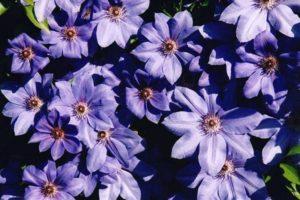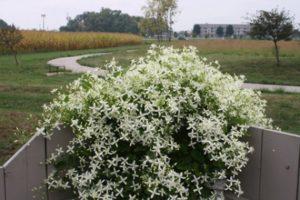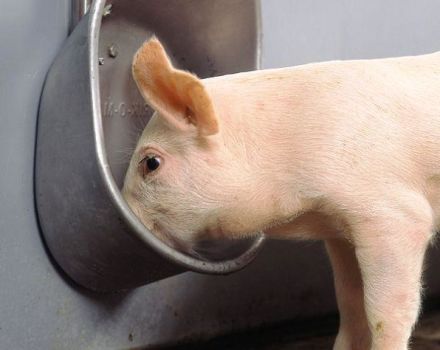Characteristics and planting of Rouge Cardinal cultivar clematis, pruning group
Large-flowered Clematis Rouge Cardinal is a climbing liana with large, velvety, rich red flowers. This perennial blooms in the second half of summer. Clematis Rouge Cardinal is grown from a purchased seedling; a large-flowered shrub cannot be obtained from seeds. After flowering, before the onset of cold weather, all shoots are cut to the ground. The next spring, new stems grow, buds appear on them again.
Description and features
Clematis Rouge Cardinal (Red Cardinal) is a climbing herb of the Buttercup family. Belongs to the Zhakman group. This is a late-flowering large-flowered shrub. A distinctive feature of this culture is its rapid growth - per day, the shoots stretch in length by 6-10 centimeters.
The tendrils of the liana are very tenacious. Clematis easily independently climbs onto the support, grabs any ledge, is fixed and stretches up. It is a perennial that remains to winter in the soil. True, before frost, shoots are cut to 20 centimeters above soil level.
Each new season clematis grows to 1.8-3 meters in length. The root goes 1 meter deep into the ground. The color of young shoots is light green. Leaves - dark green, small, leathery, pinnately compound, consisting of 3-5 leaves. Rouge Cardinal blooms from July to September. Flowers appear on the shoots of the current year. The flowering of clematis is interrupted by the first autumn frosts.
Flowers - dark red, with 6 petals, velvety, 10-16 centimeters in diameter. In the center are cream-colored filaments with brownish anthers.
Rouge Cardinal breeding history
Clematis Rouge Cardinal is a hybrid bred by French breeders in 1968. The new plant was obtained by crossing two clematis - Viticella and Lanuginose. The variety has received awards at prestigious international exhibitions many times, and was awarded a gold medal at a competition in Holland.
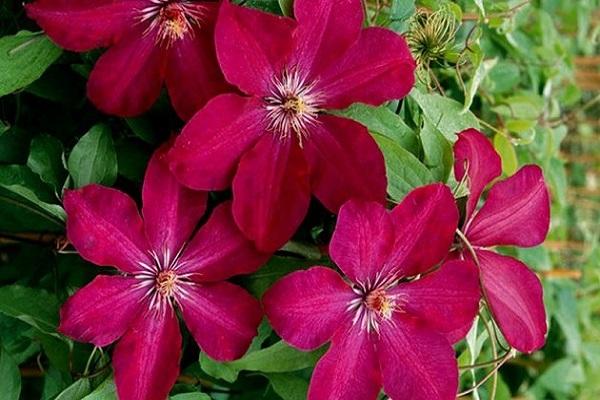
Landing
The Rouge Cardinal hybrid can be grown from a cut with a rhizome and with a twenty-centimeter shoot left after pruning with 2-3 vegetative buds, or from a seedling planted in a pot. It is easier to purchase a young clematis in a container in the spring and transfer it along with a lump of earth to a flower bed.
Site requirements
Clematis Rouge Cardinal is a light-loving crop, but can grow in light partial shade.It is better to plant a seedling in well-lit flower beds, protected from wind and drafts. The shrub does not tolerate stagnant water, the soil on which it is planted must have good drainage.
Soil selection and preparation
The land where the planting is planned can be neutral or slightly acidic. Clematis can be planted in loam or sandy loam soil. Too acidic soil must be limed. Heavy, clayey, poor soil can be diluted with peat, sand, rotted humus. The soil is prepared a few days before clematis is planted. They dug a hole, select the ground from there and mix additives.

In addition to organic matter, peat or sand, superphosphate (100 grams), 200 grams of wood ash, 100 grams of bone meal must be added. All components are mixed and poured back into the pit, leaving a small hole for planting the plant itself.
Disembarkation dates
A clematis seedling grown in a container is planted in a flower bed in May, when the soil warms up to 10 degrees Celsius, and warm weather sets in the street and the threat of night frosts passes. Rhizome with a 20 cm long shoot with 2-3 buds remaining after pruning can be planted at the end of April. In the southern regions, the delenka is planted on a flower bed in the fall (from late September to early November), 1 month before the onset of frost.
Landing scheme
2-4 weeks before planting clematis, Rouge Cardinal prepare a pit. It takes some time for the earth to settle down a little. A hole is dug out 65 centimeters deep and 55 centimeters wide. The land is enriched with humus, diluted with peat or sand. At the bottom of the hole, a ten-centimeter layer of pebbles is poured as drainage. Then the fertile soil is laid.

Before planting, you need to install a support for climbing vines. It will support clematis in case of strong winds. It is undesirable to plant the plant close to the wall of the house, preferably at a distance of 30-50 centimeters. The water flowing from the roof should not fall on the bushes. 1-1.5 meters of free area is left to the neighboring plant.
A seedling from a pot, together with a lump of earth, is carefully transferred into a previously prepared hole. The stem is covered with earth up to the first internode. After planting, a bucket of water is poured under the bush. If the soil near the bushes sags over time, you need to add some earth. When the cut is planted, the roots, along with the shoot, are deeply immersed in the soil. The root collar should be 5-8 centimeters below the soil surface. Only the top of the seedling should remain at the top.
Care rules
Clematis Rouge Cardinal is an unpretentious culture. However, in case of non-observance of the rules of agricultural technology, it may bloom poorly, wither or shed the buds. In the spring, at the beginning of growth, the vines are directed in the right direction, forced to curl around the support, tied up. If this is not done, the growing branches will intertwine or stretch in an unnecessary direction.
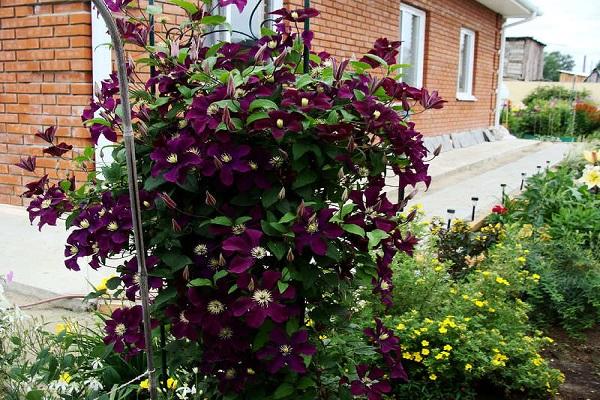
Watering
After planting, clematis should be watered regularly. Once a week, pour a bucket of water under the bush. An adult plant is watered only in dry weather. During watering, it is advisable not to allow the water jet to enter the center of the bush.
Top dressing
Clematis Rouge Cardinal responds perfectly to the introduction of organic matter and all kinds of mineral fertilizers. The shrub is fed 3-5 times per season. If clematis grows on poor soil, compost or rotted humus can be poured under the bush in the spring. Organic and mineral dressings are not applied at the same time, an interval of 10-14 days is observed.
In the summer, once a month, the foliage is sprayed with a urea solution (1 teaspoon per 10 liters of settled water). Before flowering, the bushes can be irrigated with a solution of boric acid (2 grams per 10 liters of liquid) and poured with a weak solution of potassium permanganate. In the summer, clematis is fertilized with superphosphate and potassium sulfate (35 grams per 10 liters of water).

Weeding and loosening
After watering, the land near the bushes needs to be loosened a little, weeds removed. In hot weather, to protect the roots from overheating, it is recommended to mulch the soil near clematis with peat or sawdust.
Clipping groups
Clematis must be constantly looked after. Throughout summer, remove dried or broken shoots. With the help of pruning, the height of the shrub is regulated. If you pinch the main stem, you can stop its growth and stimulate the development of side shoots. Correct autumn pruning of the shrub is of great importance. All varieties of clematis are divided into 3 groups according to the autumn pruning method. Rouge Cardinal belongs to the third group.
The first
Clematis, which bloom on the shoots of the past year, are not pruned before the onset of winter. Such plants are only slightly shortened in the fall. After all, branches grown in the new season rarely form buds. The first group includes large-petal, alpine, mountain, Siberian clematis. For the winter, frost-resistant varieties are left on a support without shelter, and the hybrids are bent to the ground and insulated.
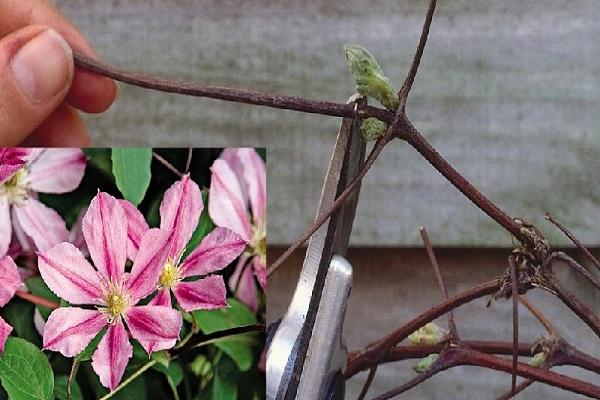
The second
Clematis, which bloom on last year's shoots and on new branches, belong to the second pruning group. In summer, old shoots are removed after flowering is complete, and in late autumn, young branches are shortened by a third. Before wintering, the plant is bent to the ground and insulated. The second group includes clematis Patens, Florida, Lanuginoza.
Third
This pruning method is suitable for Rouge Cardinal clematis. In autumn, the shoots are completely cut off. Leave only small stems 20 centimeters long, with a pair of buds. The next spring, new shoots will grow, flowers bloom on them in the middle of summer. Clematis, which are completely cut before winter, are more tenacious. The shoots of such plants do not need to be stored until the next season or insulated. The third group includes Zhakman's clematis, Intergrifolia, Vititsella.
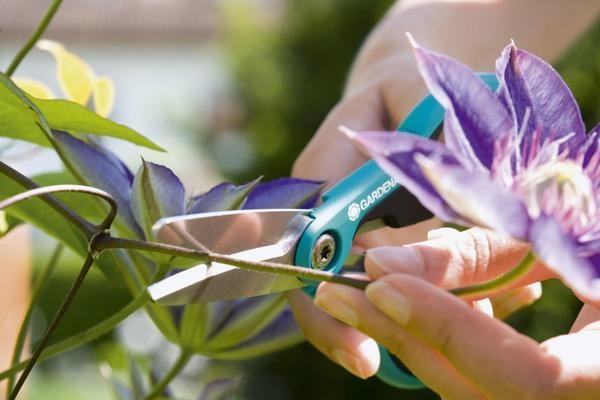
Shelter for the winter
The roots remaining in the ground and low cut stems are covered just before winter. It should be freezing outside. The base of the bush is sprinkled with peat with humus, sawdust, dry foliage. In winter, more snow is added to the place where clematis hibernates. They remove the shelter in the spring, after the snow melts.
Diseases and main pests
Clematis Rouge Cardinal can get sick with anthracnose, rot, fusarium, powdery mildew, rust. Improper care, lack of nutrients in the soil, rainy and cool weather can provoke fungal and bacterial diseases. It is advisable to carry out preventive chemical treatment of plants in the spring.
After the snow melts, before shoots appear, the soil can be watered with milk of lime (210 grams of lime per 10 liters of water).
To protect against fungal diseases, fungicides are used: Maxim, Skor, Horus, Quadris, Radomil. In hot weather, the shrub is attacked by insect pests. They are saved from preventive treatment with insecticides (Aktellik, Aktara).
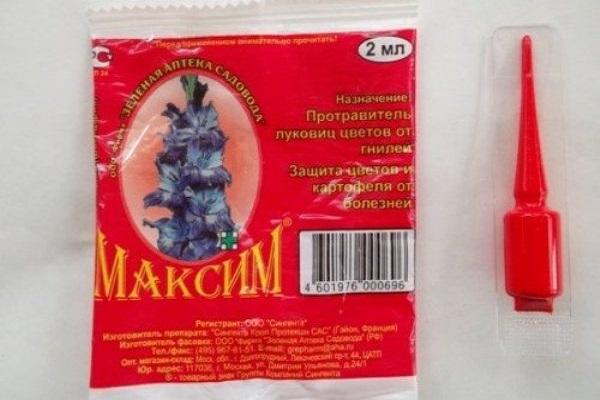
Fusarium
Fusarium wilting is caused by fungi that live in the soil. They infect the roots, penetrate the vascular system, grow, clog it with mycelium. A diseased plant quickly loses its freshness, withers, dries up. For the prevention of diseases in the spring, the earth is watered with a solution of copper or iron sulfate, in the summer a solution of Trichodermin is poured under the bush.
Wilt
Fungal infection affecting the roots and shoots of clematis. The causative agent is in the soil, penetrating through the roots into the stem, clogs up the internal vessels, disrupts their permeability. Nutrients do not go up, the plant begins to wilt and dry out. A plant affected by a fungus cannot be saved.
In the spring, preventive measures are taken to reduce the likelihood of a fungal disease.The soil is watered with a solution of potassium permanganate, Fundazol, Trichodermin, copper sulfate or Bordeaux liquid.
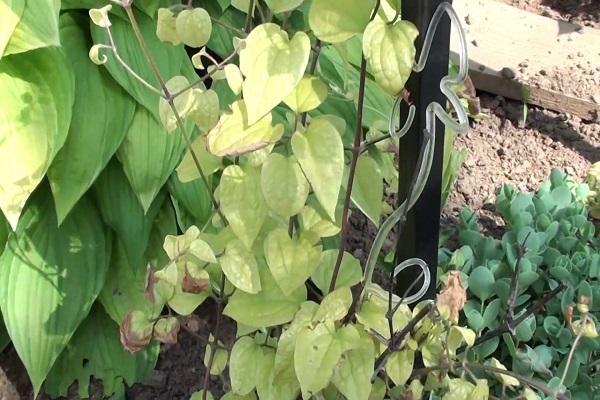
Spider mite
A tiny reddish insect that weaves a web on the back of a leaf. It becomes more active on hot days. It feeds on plant sap, which makes the leaves turn yellow and the buds dry out. Insecticides save from spider mites: Actellik, Karbofos, Inta-Vir.
Front sight
A small dipteran insect whose larvae feed on clematis leaves, creating a branched system of passages in them. The integrity of the leaf blades is violated, which is why the leaves wilt and fall off. You can save clematis from flies using a trap (sticky tape). Leaves are sprayed with insecticides as a preventive measure (Aktara, Konfidor, Mospilan).
Thrips
It is a small insect with an oblong dark brown body. Larvae and adults feed on plant sap. Insects live in the soil. In search of food, they climb clematis. Spots on the leaves, yellowing of the foliage indicate the vital activity of insects. Insecticides save from thrips: Actellik, Fufanon, Aktara, Marathon, Ortin.
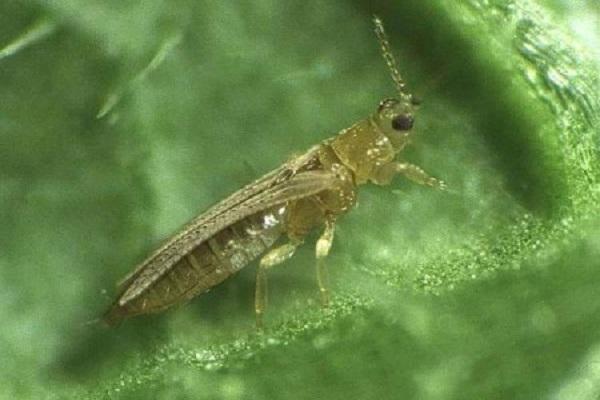
Nematodes
Microscopic worms living in the ground. Insects damage the root system of clematis. Brown swellings appear on the roots, causing rotting, which makes the bush look drooping, stops growing, withers. Clematis leaves can be attacked by another species of these insects - leaf nematodes. The vital activity of pests leads to drying and dying of foliage. Preparations save from nematodes: BI-58, Rogor, Dimethoat.
Reproduction
Clematis Rouge Cardinal is propagated mainly in a vegetative way. Large-flowered varieties cannot be grown from seeds, since the new plants do not retain the hereditary characteristics of the mother culture.
Dividing the bush
This method is used to rejuvenate the bush. With age, Clematis Rouge Cardinal begins to bloom badly, loses its decorative effect. The bush is divided in the spring, until the buds have begun to move, or in the fall - after flowering. For division, a shrub 5-8 years old is chosen. The entire ground part is cut off, leaving only short shoots with vegetative buds at the base.
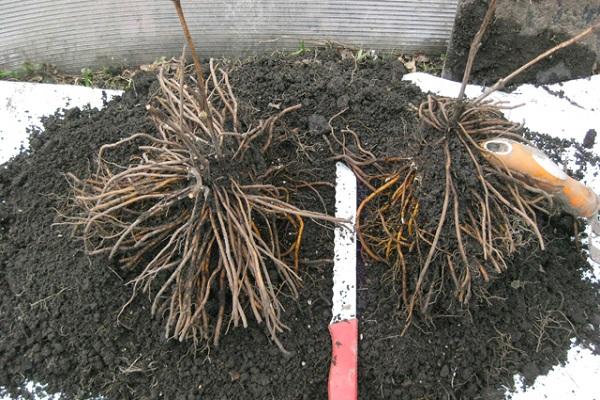
The bush is dug, the roots are separated from the ground, and they are divided into several divisions with a knife. Each part should have a shoot with buds and enough roots. An independent plant grows from each delenka.
Layers
In summer, the overgrown lower lateral stem is bent to the surface of the soil and sprinkled with earth. The top is taken out. In the second year, the branch will grow overgrown with roots, it can be cut off from the mother plant, and the emerging young shoot with roots must be transplanted to a new place.
Cuttings
In summer, slightly lignified cuttings 10-12 centimeters long are cut from the plant, the leaves are torn off and placed in water with Kornevin or Heteroauxin. Then the twigs are stuck into a wet sandy-peat substrate and covered with a plastic bottle on top. When the cuttings take root, they are transplanted to a permanent place.
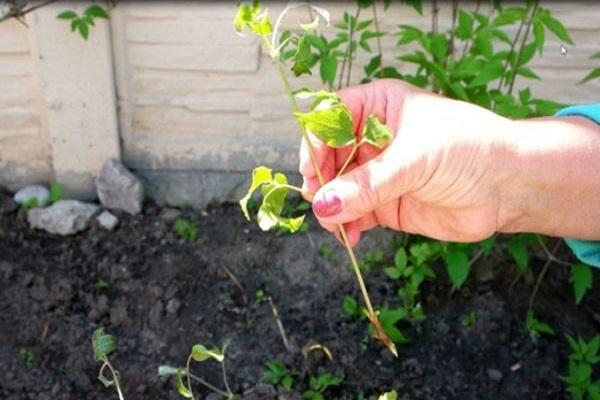
Application in landscape design
Clematis Rouge Cardinal is grown for vertical gardening of a garden plot, walls of houses, fences, balconies, terraces, pergolas, gazebos. A tenacious liana can grab any support, an arch, and climb up a tree. The plant can be grown in containers, on balconies and loggias. With proper care, clematis can grow in one place for 10-20 years.
Reviews
Valentina, 47 years old.
“I have been growing Clematis Rouge Cardinal for about 9 years. Over the summer, the vine stretches up to 2.45 meters in height, blooms profusely. In the fall, I cut off the stems, leave the shoots 20 centimeters high, sprinkle them with earth. The flower winters well, and in the spring, to stimulate growth, I feed it with nitrogen. "
